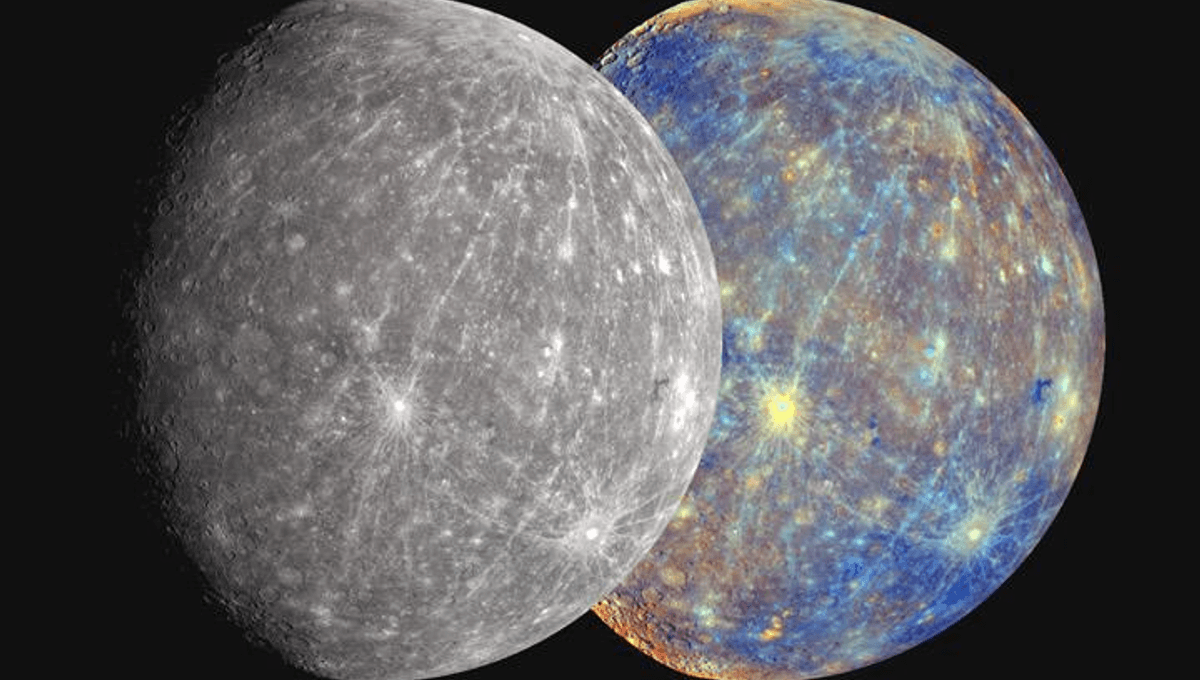
Carbon on the planet Mercury could have been compressed to form a layer of diamond beneath the crust kilometers thick, modeling suggests. When the nursery rhyme compares a star to a “diamond in the sky”, it might be accurate for one planet frequently confused with a star.
Mercury can shine quite brightly, but that’s because it is so close to the Sun a great deal of light hits it. The proportion reflected off is low, just 9 percent. The MESSENGER spacecraft revealed this is because much of the surface has plenty of graphite. Even though carbon makes up only 1-4 percent by weight, that’s about a hundred times greater than Earth, and enough to darken most of the planet.
The distribution of the graphite has led planetary scientists to conclude the carbon was there at Mercury’s formation, rather than having arrived on comets or asteroids. Yongjiang Xu of China’s Center for High Pressure Science and Technology Advanced Research has been investigating what is likely to have happened to all that carbon during the period where Mercury differentiated into core and crust from the original hot mess.
Mercury probably started off with even more carbon than it has now. However, back when its surface was a magma ocean, gases like carbon dioxide and methane would have degassed and escaped from the planet’s low gravity.
Nevertheless, Xu and co-authors write; “The abundance of graphite in the Mercurian crust indicates that the planet remained saturated in a carbon phase during metal-silicate differentiation, core formation, and the entirety of magma ocean crystallization.”
It’s not just carbon that makes diamonds, however – you need pressure as well. Mercury is a smaller planet with less gravity than Earth, and the pressure in its ancient magma ocean and mantle was thought insufficient to make the gems. Instead, carbon that was not bonded to anything else was thought to have all been in the form of graphite, which floated to the surface.
New models of Mercury’s gravity field call this into question. This inspired the authors of this paper to expose samples of the elements that might have been present in Mercury at the time to 7 gigapascals of pressure at almost 2,000° C (3,600° F).
There are two scenarios where diamonds could have been formed. Either they were produced from the magma ocean, a stage thought to have been common to all the inner planets, or they were squeezed out of the core as it crystallized.
The first scenario is only possible if Mercury had quite a lot of sulfur in its magma ocean, the authors found, as this would have changed the chemistry to the point where diamond production was possible. Even if sulfur was abundant, the authors consider large-scale diamond production improbable, although not impossible.
However, they consider the core scenario much more likely. As the solid inner core formed, carbon would have been forced out, leading to a diamond layer kilometers thick. High temperatures could have burned the outer parts of this layer back to graphite. How much would have been lost this way is unclear, but much of it could survive, sitting between Mercury’s core and its silicate mantle. The conductivity of this diamond layer might contribute to Mercury’s magnetic field.
The layer is probably not a single shell kilometers thick, but senior author Dr Bernard Charlier of the University of Liege told New Scientist. “Let’s be honest,” he says, “We have no idea about the potential size of those diamonds.”
The study is published open access in the journal Nature Communications.
Source Link: A Thick Layer Of Diamonds May Lurk Beneath Mercury’s Surface